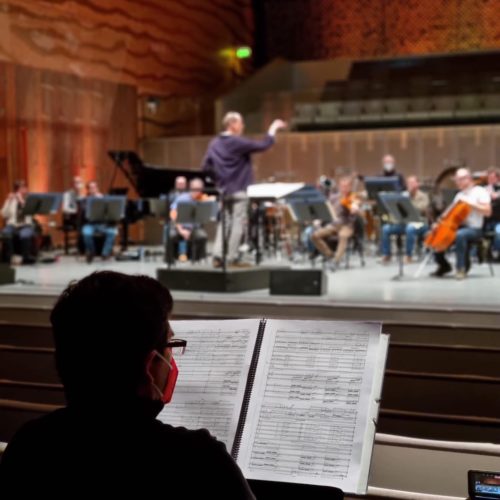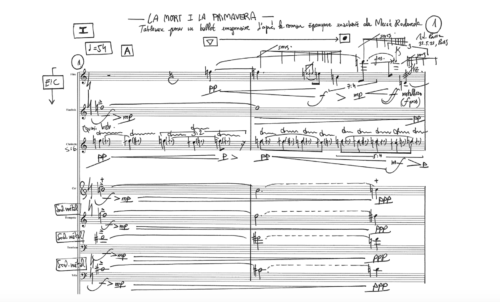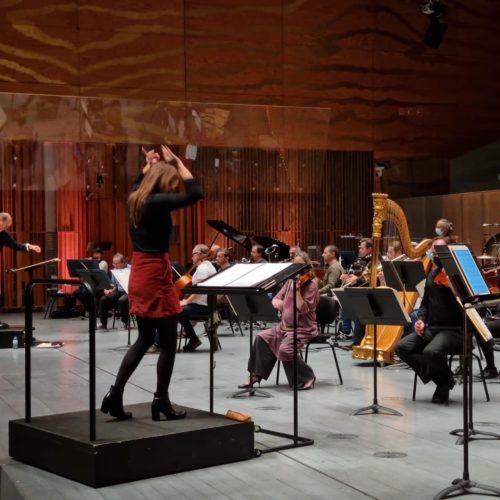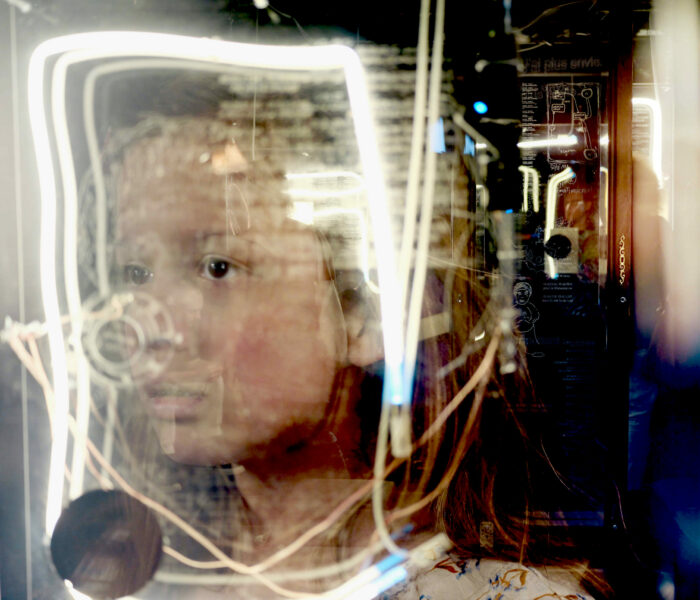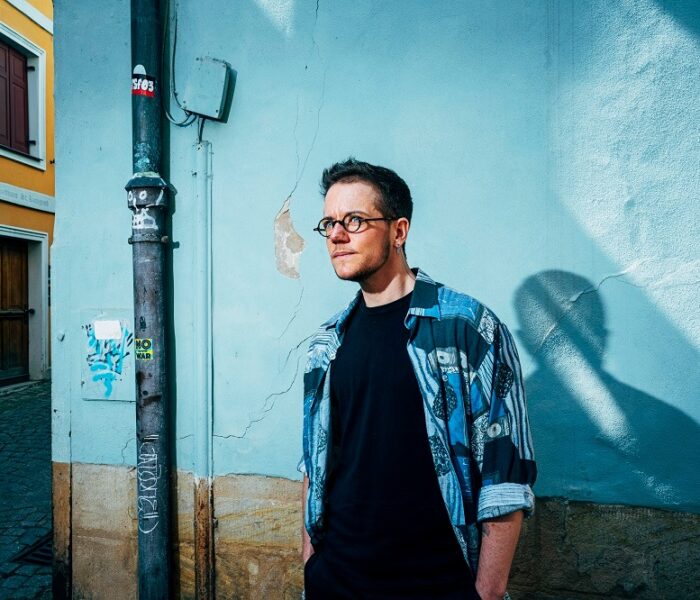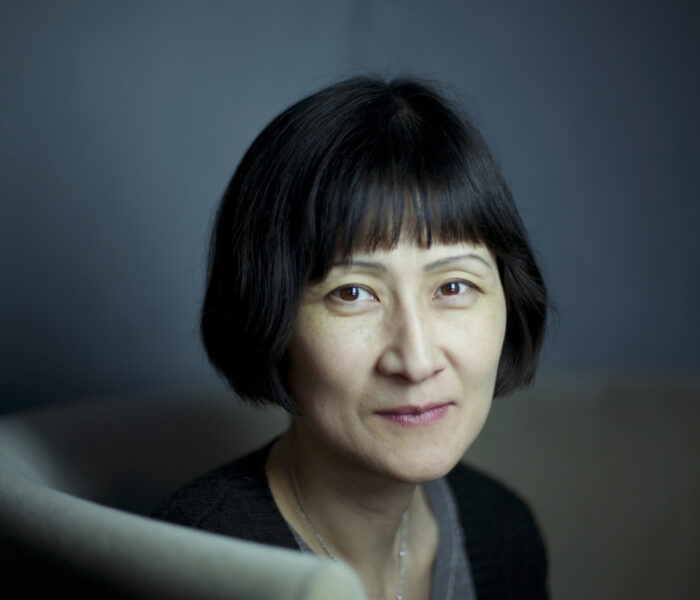Elle préfère le genre neutre anglais, « the conductor », pour nous parler de son métier de cheffe d’orchestre dans lequel elle est aujourd’hui pleinement engagée, forte d’un métier solide, d’une organisation sans faille et d’une bonne dose d’énergie positive. Présente à l’international, sur les podiums des grandes phalanges orchestrales, la jeune trentenaire Lucie Leguay compte bien aborder tous les répertoires, celui de l’opéra qu’elle chérit particulièrement et des musiques d’aujourd’hui qui font partie intégrante de son apprentissage, de sa pratique et de sa réputation. Elle revient pour nous sur un début de carrière fulgurant et une actualité non moins excitante, invitée sur les scènes de la Casa da Música à Porto et de la Cité de la musique à Paris pour un concert de créations plutôt original.
Vous avez été cheffe assistante de cinq formations entre 2019 et 2021 ; puis nommée assistante de Mikko Franck en 2021 avec qui vous travaillez encore cette année. Comment envisagez-vous votre parcours aujourd’hui?
J’ai en effet assumé les postes d’assistante de l’Orchestre de Lille, de l’ONDIF (Orchestre National d’Île de France), de Picardie et du Festival de Verbier dans la même année! Je ne m’attendais pas à obtenir celui de l’Ensemble Intercontemporain (EIC) quelques mois plus tard, invitation que je me suis empressée d’accepter, bien évidemment. La tâche a été lourde mais ô combien enrichissante car j’ai compris, auprès de Matthias Pintscher, que la musique contemporaine se dirigeait comme celle du répertoire, avec la précision du détail, certes, mais aussi la présence des couleurs et du phrasé. Mes contacts familiers avec le symphonique et l’opéra ont nourri cette approche de l’écriture d’aujourd’hui qui, à son tour, m’a fait entendre autrement les musiques du passé. J’avais déjà l’opportunité de diriger en France et à l’étranger à cette époque, invitations qui se multiplient aujourd’hui et que je peux honorer avec une plus grande disponibilité : comme ce projet d’opéra au mois de mars prochain avec le Conservatoire de Paris, Die Fledermaus de Johann Strauss, qui me réjouit. Je travaille également beaucoup avec l’Allemagne, Amsterdam, le Brussels Philharmonic ; j’ai collaboré récemment avec l’Orchestre de Strasbourg ; je serai à Bordeaux en 2023 ; j’ai noué des partenariats avec les orchestres de Munich et de Buenos Aires. Depuis mon passage à l’EIC, on m’appelle beaucoup aujourd’hui pour des projets de musique contemporaine, à Genève avec le Lemanic Ensemble et Contrechamps et à Francfort, avec l’Ensemble Modern. Mais je tiens à être active sur tous les fronts, diriger toutes les musiques et surtout rester ouverte à de nouveaux répertoires.
Vous venez d’assister Matthias Pintscher dans Tutuguri de Wolfgang Rihm ; c’était je crois, votre dernière collaboration avec lui? Parlez-nous du travail à ses côtés. Quel enseignement en avez-vous tiré?
La musique contemporaine a toujours été inscrite dans mon apprentissage, que ce soit avec Peter Eötvös et ses master-class à Budapest, avec Jean-Sébastien Béreau auprès de qui j’ai travaillé près de dix années ou encore avec mon professeur de direction à la Haute-École de Musique de Lausanne. Mes deux années et demi à l’EIC m’ont fait découvrir un immense répertoire, surtout en temps de Covid où l’on m’a beaucoup appelée pour remplacer au pied levé des chefs absents ; j’ai absorbé énormément de musiques d’aujourd’hui et j’ai beaucoup appris au contact des musiciens de l’EIC et de Matthias Pintscher. L’énergie positive, l’enthousiasme qu’il dégage, sa manière de travailler, de guider les musiciens dans le son et les couleurs sont autant de notions que je partage avec lui. Matthias Pintscher est une rencontre très importante dans mon parcours.
La position de chef n’est certainement pas la même face à un ensemble ou à un orchestre…
Elle change évidemment radicalement, sur le plan des relations avec les musiciens avant tout. J’ai pu tisser des liens particuliers avec chacun des solistes de l’EIC, ce qui est plus compliqué avec un orchestre symphonique, surtout en tant que cheffe invitée. Mais j’aime l’une et l’autre des expériences. J’ai fait avec l’Intercontemporain, juste après le confinement, un projet un peu fou qui nous a véritablement soudé : la création mondiale de vingt pièces commandées à autant de compositeurs dans une période de grand désarroi qui a mis du baume au cœur de chacun.
Quelle place la musique d’aujourd’hui va-t-elle occuper dans votre parcours de cheffe?
Une place importante que je voudrais toujours défendre ; s’il m’arrive d’être réinvitée par un orchestre, comme c’est le cas avec l’Orchestre de Bretagne, j’ai à cœur de leur proposer au sein du programme qu’on décide ensemble une pièce contemporaine. Le Brussels Philharmonic n’a pas hésité à inscrire une création d’un jeune compositeur flamand dans le concert que je vais diriger, connaissant mon expérience dans ce domaine. Et je compte bien défendre la création auprès de ces grandes phalanges parfois un peu frileuses à son égard. J’ai un souvenir ému de ce concert avec l’Orchestre de Strasbourg, Silence(s), présenté par Clément Lebrun en direction des enfants, où les répertoires et les styles se sont côtoyés avec un vrai bonheur. J’y ai dirigé, entre Brahms et Ravel, quatre œuvres de musique contemporaine dont une création!
A ce propos, vous dirigez l’Ensemble Intercontemporain le 26 janvier prochain à la Philharmonie de Paris où une nouvelle œuvre du compositeur catalan Hèctor Parra, La mort i la primavera pour deux ensembles et deux chefs est à l’affiche. C’est un compositeur avec qui vous avez déjà collaboré?
C’est la toute première fois que je dirige sa musique et c’est toujours une joie pour moi de rentrer en contact avec un compositeur et son univers sonore. Il était là à la première répétition pour nous présenter sa pièce, raconter l’histoire qui la sous-tend, un récit tiré du roman de l’écrivaine catalane Mercè Rodoreda, et nous amener au plus près de son projet sonore. Le lendemain, il partait à Porto pour refaire cette même présentation auprès du Remix Ensemble et de Peter Rundel qui dirige avec moi. On a pris le temps de travailler sur les couleurs, les places d’archet pour les cordes, les équilibres et l’esprit de la pièce. Il était content de cette première lecture, déjà satisfait du résultat sonore obtenu. On sent chez lui une vraie connivence avec des musiciens qu’il connaît bien et pour lesquels il a écrit. Dans sa partition, les bois (flûte, hautbois et clarinette) sont mis en avant dans une évocation de la nature ; lui-même donne aux musiciens des images de fleurs qui s’ouvrent. L’écriture y est très fouillée, au service du timbre qu’il veut entendre. Et de fait, j’avais déjà en la lisant, lors de mon travail à la table, une musique qui chantait dans ma tête. Hèctor Parra compare la polyphonie à un tissu musculaire déployant une énergie physique et assimile le mouvement de sa musique à des corps qui dansent. La mort i la primavera est sous-titrée ballet imaginaire.
Combien de temps nécessite la préparation d’une telle partition.
On ne peut anticiper qu’en fonction du moment où l’on reçoit la partition… Je l’ai eue fin décembre ; je m’y suis penchée durant une semaine en fin d’année et quelques quinze jours ensuite ; j’avais besoin d’assimiler cette écriture foisonnante et d’en maîtriser la forme globale ainsi que la structure qui doit prendre en compte la partition de l’autre ensemble. On peut avoir des mesures et des tempi qui se superposent ; c’est une difficulté supplémentaire, l’exigence d’une grande précision concernant ma partie et d’une parfaite synchronisation entre les deux.
D’un point de vue pratique, comment travaillez-vous en amont?
C’est d’abord un travail à la table qui est très important et consiste à annoter la partition pour mieux visualiser le discours musical. En premier lieu, j’indique les carrures, c’est-à dire l’articulation par phrases musicales successives ; je note les battues au-dessus des portées, en gros : une manière boulézienne que m’a transmise Jean-Sébastien Béreau ; j’inscris les coups d’archet pour les cordes, les entrées de chaque pupitre, tout ce que je dois faire passer à travers mes gestes.
Vous arrive-t-il d’aller au piano?
J’y suis allée en effet pour La mort i la primavera afin d’appréhender la dimension harmonique de l’écriture qui tient l’édifice architectonique.
Vous avez débuté la direction avec Jean-Sébastien Béreau qui est une personnalité qui a beaucoup compté pour vous. Comment s’est faite cette rencontre?
Quand je l’ai rencontré, il avait 71 ans, il donnait des cours à Lille où j’étudiais le piano. Il avait enseigné au Conservatoire National Supérieur de Musique de Paris pendant des années. C’est lui qui m’a mis le pied à l’étrier en me donnant la possibilité de travailler avec un orchestre et non pas deux pianos comme c’est souvent le cas dans les études de direction. Nous avons travaillé ensemble pendant trois ou quatre ans mais j’ai noué avec lui un lien très fort. Il habite aujourd’hui au Portugal où il a fondé une académie de direction d’orchestre à Leiria. C’est là que je me suis rendue tous les étés, pendant presque dix ans, pour continuer à suivre ses conseils. Il m’a transmis l’héritage de la musique française.
Parlons de vos autres mentors. Avez-vous rencontré Pierre Boulez?
Hélas non. Je demande souvent aux musiciens de l’EIC de me livrer leurs souvenirs au côté du maître car il y a peu de témoignages sonores de sa pratique de direction. Après ma formation avec J.S.Béreau, j’ai rencontré Aurélien Azan Zielinski à la Haute École de Musique de Lausanne durant mon master de direction. Je ne pouvais pas trouver personnalité aussi éloignée de celle de J.S. Béreau. Il m’a ouvert de nouveaux horizons ; j’ai découvert et développé d’autres choses, d’autres manières de penser la musique et le geste dans l’espace, de gérer ma relation aux musiciens. Puis, en tant qu’assistante, au Festival de Verbier notamment, j’ai reçu les conseils de Valery Gergiev, de Daniel Harding, Klaus Mäkelä et Antonio Pappano. Ça ne durait qu’une semaine, mais j’ai beaucoup appris, ne serait-ce qu’en les regardant diriger. J’ai aussi une admiration sans borne pour le geste de Simon Rattle dont j’ai pu m’imprégner via le Digital Konzert Hall des Berliner Philharmoniker. Son travail avec le pupitre des cordes notamment est admirable.
Qu’est-ce qui vous attache concrètement à l’orchestre?
J’aime partager avec les musiciens. C’est quelque chose qui m’a manqué en tant que pianiste, même si j’ai pratiqué la musique de chambre. J’ai ressenti, depuis mes années de collège où j’étais dans les classes à horaires aménagés, une frustration de ne pas pouvoir intégrer l’orchestre et être avec les autres. Et quand l’occasion m’a été offerte de jouer pour la première fois du piano au sein d’un orchestre, j’ai alors ressenti cette vibration et cette énergie qui m’ont donné l’envie de diriger. J’aime beaucoup l’idée de changer de phalanges, d’une semaine à l’autre, d’un lieu à un autre, pour découvrir de nouveaux talents et d’autres sonorités à chacun de mes engagements.
Quelle a été votre première expérience de cheffe?
Je ne suis pas prête de l’oublier! J’avais 18 ans, c’était à neuf heures du matin, un dimanche, devant la classe de Jean-Sébastien Béreau, avec sur le pupitre la Symphonie n°2 de Beethoven. J’ai alors découvert cette manière extraordinaire de créer du son sans toucher l’instrument, de sentir à travers mon geste la possibilité de modeler le son. J’avais véritablement trouvé ma voie.
Vous avez gagné le Tremplin des jeunes cheffes à la Philharmonie en 2018 ; que pensez-vous du concours de La Maestra instauré en 2020?
Je voudrais d’abord revenir sur le concours du « Tremplin » auquel je n’avais guère envie de m’inscrire. J’ai en effet une toute autre conception de la parité même si je ne peux qu’approuver cette initiative et cet élan en direction des femmes qui sont restées trop longtemps à l’écart. La présence au jury d’un grand nombre de directeurs de salles prêts à faire monter des cheffes sur le podium m’a décidé à m’inscrire, pour les rencontrer et les convaincre. Gagner le concours a, en effet, généré beaucoup d’invitations à une période où j’étais déjà très occupée par mes postes d’assistante. Cela a véritablement lancé ma carrière. J’ai également été choisie pour la web-série « chef.fe » initiée par la Philharmonie qui m’a suivie sur cinq projets, mettant en lumière le métier de direction souvent peu connu du grand public. Mais j’ai refusé de faire le concours de la Maestra, peinée pour les collègues masculins de mon âge qui sont aujourd’hui, et à leur tour, délaissés! Il faut une juste mesure des choses et sentir que nous sommes choisies non pas pour notre genre mais pour notre mérite et notre personnalité. Ce qui m’a amenée d’ailleurs à refuser certains projets qui n’avaient pas cette exigence.
Avez-vous le sentiment que les choses ont évolué en ce qui concerne la place des femmes sur le podium?
Clairement. Je dirais que la présence d’une femme à la tête d’un orchestre est presque devenue une chose normale, Du moins, c’est ainsi que je le ressens. Il en est de même pour les compositrices. Mais il faut rester vigilant et d’abord évaluer les compétences avant de parler de genre.
Avez-vous conscience d’être un modèle pour la future génération de cheffe?
Je vous dirai que je n’ai pas eu besoin de modèles féminins pour faire ce métier. Mais j’ai conscience que la présence des femmes à la tête d’un orchestre peut aujourd’hui éveiller des vocations. J’ai travaillé avec l’orchestre Demos à Lille où les enfants avaient deux chefs, Alexandre Bloch, actuel directeur de l’Orchestre de Lille, et moi-même. Je pense qu’il est bon de montrer aux enfants, filles et garçons d’ailleurs, que le métier de chef est mixte. L’image est importante à transmettre.
Vous avez créé l’Orchestre de chambre de Lille en 2014? C’est une phalange à laquelle vous étiez attachée et qui vous a permis de faire nombre d’expériences, notamment de croiser les répertoires, d’imaginer d’autres formats de concert et de rencontrer d’autres publics. Est-ce une mission que vous allez poursuivre?
J’ai beaucoup appris à travers ce projet où je m’occupais de tout, administration, trésorerie, production, direction, etc. Le covid a stoppé net notre activité et je dois dire que je n’ai plus le temps de m’y consacrer depuis. Si les choses reprennent, ce que je souhaite, il me faudra d’autres moyens financiers pour pouvoir déléguer les responsabilités.
Quel est aujourd’hui votre rêve de cheffe?
Ils sont nombreux : faire un grand opéra de Strauss ou une symphonie de Brahms, ou encore un ballet de Stravinsky, avec les danseurs sur scène…
Propos recueillis par Michèle Tosi
Concert “Du simple au double“, mercredi 26 janvier à la Philharmonie de Paris;
Retrouvez les documentaires de Camille Ducellier, ici



)
